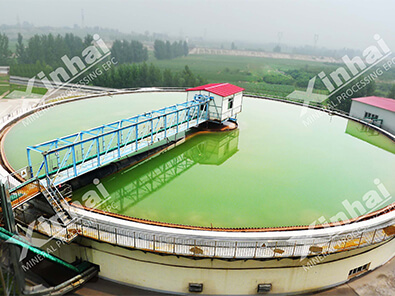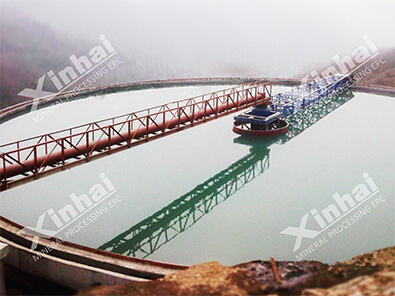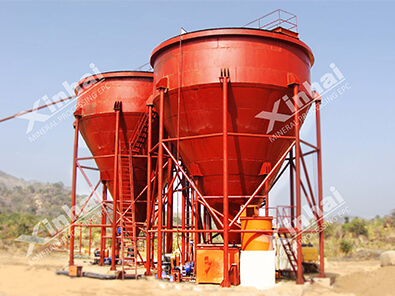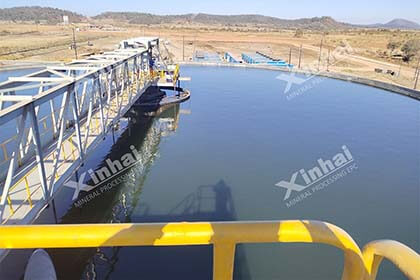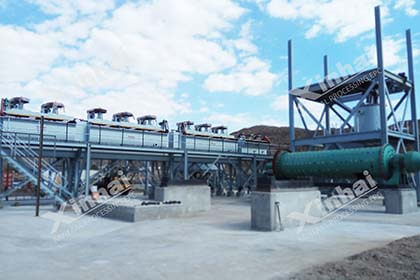Comprehensive Guide to Mining Thickeners
 Essow
Essow
 Nov 23, 2023
Nov 23, 2023
 3034
3034
If you want to know more details about equipment, solutions, etc, please click the button below for free consultation, or leave your requirements!

Mining thickeners are crucial components in mineral processing operations, playing a vital role in enhancing process efficiency and managing tailings effectively. This comprehensive guide explores the key aspects of mining thickeners, including their functions, types, design considerations, operation, and maintenance. By understanding the principles and best practices associated with thickeners, mining professionals can optimize their operations, improve water recovery, and minimize environmental impact.
01 Understanding Mining Thickeners
Back1. Definition and Purpose
Mining thickeners, also known as clarifiers or settlers, are large sedimentation tanks used in mineral processing operations. They are designed to separate solids from liquids, allowing for the efficient concentration of solids and the recovery of valuable minerals. Thickeners utilize gravity sedimentation to facilitate the separation process.
2. Importance of Thickeners in Mining Operations
Thickeners play a critical role in various stages of mining operations. They are commonly used in the processing of ores to separate solid particles from the process liquids, such as water or chemical solutions. Thickeners are particularly crucial in tailings management, where they help separate solid tailings from water, enabling efficient disposal or recycling of water and reducing the environmental impact.
3. Role in Tailings Management
Tailings, the by-products of mineral processing, often contain fine particles and water. Thickeners are extensively used to dewater and thicken the tailings, reducing their volume and facilitating proper disposal or storage. By separating the solids from the water, thickeners enable the recycling of water for reuse in the mining process, minimizing the need for fresh water intake and reducing the demand on natural water sources.
Thickeners also aid in the recovery of process water from the tailings, which can be reused in the plant, reducing water consumption and operational costs. Effective tailings management through thickeners helps to mitigate environmental risks associated with tailings storage, such as water pollution and land degradation.
02 Types of Mining Thickeners
BackMining thickeners are available in various types, each designed to meet specific process requirements and operational needs. Understanding the different types of thickeners is essential for selecting the most suitable option for a mining operation. Here are some common types of mining thickeners:

(Thickners)
1. Conventional Thickeners
Conventional thickeners, also known as sedimentation thickeners, are the most basic type. They consist of a large, cylindrical tank with a central feed well and a peripheral overflow launder. The feed suspension enters the tank through the feed well, and the solids settle at the bottom while the clarified liquid overflows from the peripheral launder. Conventional thickeners are commonly used in applications where high solids concentration is not required.
2. High-Rate Thickeners
High-rate thickeners are designed to handle higher solids concentrations and provide higher throughput rates compared to conventional thickeners. They feature a deeper tank with a steeper floor slope, allowing for faster settling of solids. High-rate thickeners employ a feed well and a unique feed dilution system, which improves the efficiency of solids settling. These thickeners are ideal for applications where a high underflow density is desired or where space is limited.
3. Paste Thickeners
Paste thickeners are specifically designed to handle high-density, non-settling slurries or paste-like materials. They are commonly used in applications where the goal is to produce a thickened slurry with a high solids concentration, typically for disposal or transportation purposes. Paste thickeners have a deep cone design that promotes the compaction of solids, resulting in a dense and non-segregating underflow. They are widely employed in tailings management to minimize water content in the final tailings discharge.
4. Deep Cone Thickeners
Deep cone thickeners, also known as deep bed or deep cone clarifiers, are suitable for applications that require both high underflow density and efficient clarification of the supernatant liquid. These thickeners feature a steep-sided cone-shaped tank, which promotes enhanced settling of solids. The deep cone design allows for a larger settling area and provides improved retention time for effective solids-liquid separation. Deep cone thickeners are commonly used in processes where particle settling rates vary or where solids compression is beneficial.
5. Selecting the Appropriate Thickener Type
The selection of the most suitable thickener type depends on various factors, including the characteristics of the feed suspension, required underflow density, throughput capacity, available space, and process objectives. It is essential to consider the specific requirements of the mining operation and consult with experts or manufacturers to determine the optimal thickener type.
By choosing the right type of thickener, mining operations can achieve efficient solids-liquid separation, maximize water recovery, and optimize tailings management. Each type of thickener offers unique advantages in terms of performance, space utilization, and operational flexibility. Proper selection and application of thickeners contribute to improved process efficiency, reduced water consumption, and enhanced environmental sustainability in mining operations.
03 Design Considerations
BackThe design of mining thickeners is a critical aspect that directly impacts their performance, efficiency, and operational reliability. Considerations related to various design parameters must be taken into account to ensure optimal thickener operation. Here are some key design considerations for mining thickeners:
1. Feedwell Design and Optimization
The feedwell is an essential component of a thickener, responsible for distributing the incoming feed suspension evenly across the thickener diameter. Proper feedwell design and optimization ensure uniform distribution and minimize short-circuiting, which can negatively impact thickener performance. Factors such as feedwell geometry, baffling, and flow control mechanisms need to be carefully considered to achieve optimal feed distribution.
2. Settling Zone Design
The settling zone is where the separation of solids from the liquid occurs within the thickener. Design considerations for the settling zone include the tank diameter, depth, and slope of the tank floor. A larger settling zone with an appropriate floor slope allows for effective settling of solids, resulting in improved thickening efficiency. It is important to optimize these design parameters based on the characteristics of the feed material and desired underflow density.
3. Rake Design and Operation
Rakes are responsible for continuously removing settled solids from the bottom of the thickener. The design of the rake mechanism and its operation play a crucial role in maintaining efficient thickener performance. Considerations include rake arm design, rake torque requirements, and the speed of rotation. Proper rake design ensures effective solids removal without disturbing the settled bed excessively, while adequate rake torque prevents slippage or overload conditions.
4. Underflow Discharge Arrangements
Efficient underflow discharge is important for proper thickener operation. Design considerations for underflow discharge include the design of the discharge cone, the size and location of underflow outlets, and the arrangement of underflow pumps or valves. Optimal design ensures the smooth flow of thickened underflow and minimizes the risk of blockages or uneven distribution.
5. Thickener Sizing and Capacity
Thickener sizing involves determining the appropriate dimensions, tank capacity, and throughput capacity based on process requirements. Factors such as solids loading rate, settling characteristics of the feed, and desired underflow density need to be considered for proper thickener sizing. Oversizing or undersizing a thickener can lead to inefficiencies, increased energy consumption, and compromised performance.
Proper design considerations are crucial for achieving optimal thickener performance and maximizing solids-liquid separation efficiency. It is recommended to involve experienced engineers, process experts, or thickener manufacturers during the design phase to ensure that all design parameters are carefully evaluated and optimized.
Additionally, advancements in computer modeling and simulation tools can aid in the design process by providing insights into fluid dynamics, solids settling behavior, and overall thickener performance. These tools can help optimize the design and predict the expected performance of a thickener under various operating conditions.
By carefully considering and optimizing the design parameters, mining operations can enhance thickener efficiency, increase solids concentration, improve water recovery, and minimize operational costs. Well-designed thickeners contribute to sustainable mining practices by reducing water consumption, improving tailings management, and promoting overall process efficiency.

(High Efficiency Thickener)
04 Thickener Operation and Control
BackEfficient and effective operation and control of mining thickeners are essential for achieving optimal performance, maximizing solids-liquid separation, and ensuring smooth operation. Proper control strategies and operational practices help maintain desired underflow density, minimize water loss, and enhance overall thickener efficiency. Here are key aspects of thickener operation and control:
1. Feed System and Dilution Control
The feed system plays a crucial role in thickener operation. It is important to ensure a constant and controlled feed flow rate to the thickener to maintain optimal performance. Proper feed dilution is also critical, as it affects the settling characteristics of the solids and the efficiency of solids separation. Dilution control mechanisms, such as flow control valves or pumps, should be employed to achieve the desired feed dilution rate.
2. Flocculant Addition and Mixing
Flocculants are chemicals used to aid in the aggregation and settling of fine particles in the thickener. Proper flocculant addition and mixing ensure effective flocculation and improve solids settling rates. The flocculant dosage and injection points should be optimized based on the characteristics of the feed material. Adequate mixing mechanisms, such as mechanical or hydraulic mixers, should be employed to facilitate uniform distribution of flocculants throughout the feed suspension.
3. Solids Concentration Control
Maintaining the desired underflow density or solids concentration is crucial for efficient thickener operation. Solids concentration control ensures that the thickener operates within the desired range and avoids issues such as overflows or excessive underflows. Control mechanisms, such as bed level detectors or density meters, are used to monitor and adjust the solids concentration in the thickener. These measurements are utilized to control the flocculant dosage, dilution rate, or underflow discharge rate to achieve the desired underflow density.
4. Rake Speed and Torque
Proper control of the rake speed and torque is essential for effective solids removal and preventing rake overload. The rake speed should be optimized to maintain an adequate flow of settled solids without disturbing the settled bed excessively. Monitoring rake torque provides insights into the load on the rake mechanism and helps prevent overload conditions. Control systems can adjust the rake speed and torque based on real-time measurements to ensure optimal rake performance.
5. Bed Level and Interface Detection
Monitoring the bed level and interface detection in the thickener is crucial for proper operation and control. Bed level measurement provides information about the height of the settled solids bed, while interface detection helps identify the interface between the clarified liquid and the settled solids. These measurements enable control systems to adjust the underflow discharge rate, rake operation, and other parameters to maintain the desired thickener performance.
6. Thickener Automation and Control Systems
Advancements in automation and control systems have significantly improved thickener operation and control. Modern thickener control systems utilize real-time data from various sensors and instruments to monitor and control key parameters. These systems can automatically adjust variables such as flocculant dosage, dilution rate, underflow discharge rate, and rake speed based on pre-set control strategies or algorithms. Automation not only improves operational efficiency but also reduces the risk of human error and allows for continuous optimization of thickener performance.
Proper thickener operation and control require regular monitoring of key parameters, such as feed flow rate, dilution rate, underflow density, bed level, and interface detection. It is important to establish control strategies, set alarm limits, and implement feedback mechanisms to maintain optimal thickener performance. Regular calibration and maintenance of instruments and sensors are also essential to ensure accurate measurements and reliable control.
05 Thickener Performance Monitoring and Optimization
BackMonitoring and optimizing the performance of mining thickeners is crucial for achieving efficient solids-liquid separation, maximizing water recovery, and minimizing operational costs. By continuously monitoring key performance parameters and implementing optimization strategies, mining operations can improve thickener efficiency and overall process performance. Here are the key aspects of thickener performance monitoring and optimization:
1. Performance Parameters
Several key parameters should be monitored to assess thickener performance. These include underflow density or solids concentration, overflow clarity, bed level, rake torque, flocculant dosage, and feed and dilution rates. Monitoring these parameters provides insights into the efficiency of solids settling, the clarity of the clarified liquid, the effectiveness of flocculation, and the overall thickener operation. Real-time data collection and analysis systems are employed to monitor these parameters continuously.
2. Sampling and Laboratory Analysis
Regular sampling of thickener feed, underflow, and overflow streams is essential for comprehensive performance monitoring. These samples are subjected to laboratory analysis to determine parameters such as solids concentration, particle size distribution, settling rate, flocculant effectiveness, and overflow quality. Laboratory data provides valuable information for assessing thickener performance, identifying potential issues, and optimizing process parameters.
3. Data Analysis and Trending
Data analysis plays a crucial role in thickener performance monitoring and optimization. Historical data, real-time measurements, and laboratory analysis results are analyzed to identify trends, patterns, and potential deviations from optimal performance. Advanced data analysis techniques, such as statistical analysis, trend analysis, and data visualization, are employed to gain insights into thickener behavior and identify opportunities for improvement.
4. Optimization Strategies
Based on data analysis and performance assessment, optimization strategies can be developed and implemented to enhance thickener performance. These strategies may include adjustments to flocculant dosage, dilution rate, underflow discharge rate, rake speed, or other process parameters. Optimization strategies aim to maximize solids settling efficiency, improve underflow density, enhance overflow clarity, minimize water loss, and reduce operational costs. It is important to consider the specific characteristics of the ore and tailings, as well as the process requirements, when developing optimization strategies.
5. Advanced Control Systems
Advanced control systems, such as model predictive control (MPC) or expert systems, can be employed to optimize thickener performance. These systems utilize real-time data, historical trends, and process models to predict the behavior of the thickener and optimize control actions. Advanced control systems can automatically adjust process parameters, such as flocculant dosage, dilution rate, or underflow discharge rate, based on real-time measurements and optimization algorithms. These systems enable continuous optimization of thickener operation and improve overall process efficiency.
6. Regular Maintenance and Equipment Inspection
Regular maintenance and inspection of thickener components are essential for optimal performance. This includes checking the condition of rake mechanisms, drive units, feed systems, and other critical components. Routine inspections help identify and address any mechanical issues, such as excessive wear or misalignment that can affect thickener performance. Adequate lubrication, alignment, and preventive maintenance practices are crucial to ensure reliable and efficient thickener operation.
7. Continuous Improvement and Training
Thickener performance monitoring and optimization should be considered as an ongoing process of continuous improvement. It is important to foster a culture of continuous improvement within the mining operation and provide training to operators and maintenance personnel. Regular performance reviews, knowledge sharing, and training sessions help identify best practices, share lessons learned, and keep personnel updated on the latest advancements in thickener operation and optimization.
06Conclusion
BackMining thickeners are integral to efficient mineral processing and sustainable tailings management. By implementing proper design, operation, and maintenance practices, mining professionals can optimize thickener performance, improve water recovery, and minimize environmental footprint. This comprehensive guide serves as a valuable resource for understanding the principles, types, operation, and optimization strategies associated with mining thickeners. By harnessing the knowledge and best practices outlined in this guide, mining operations can enhance their operational efficiency, reduce costs, and contribute to a more sustainable mining industry.
We also have many articles about thickeners, please click the links to check them.
A Comprehensive Guide to Thickener Maintenance
A Comprehensive Guide to the Operation of Thickener
 +86 18716000713
+86 18716000713 xlyin@xinhaimining.net
xlyin@xinhaimining.net




 Message
Message Chat Now
Chat Now


